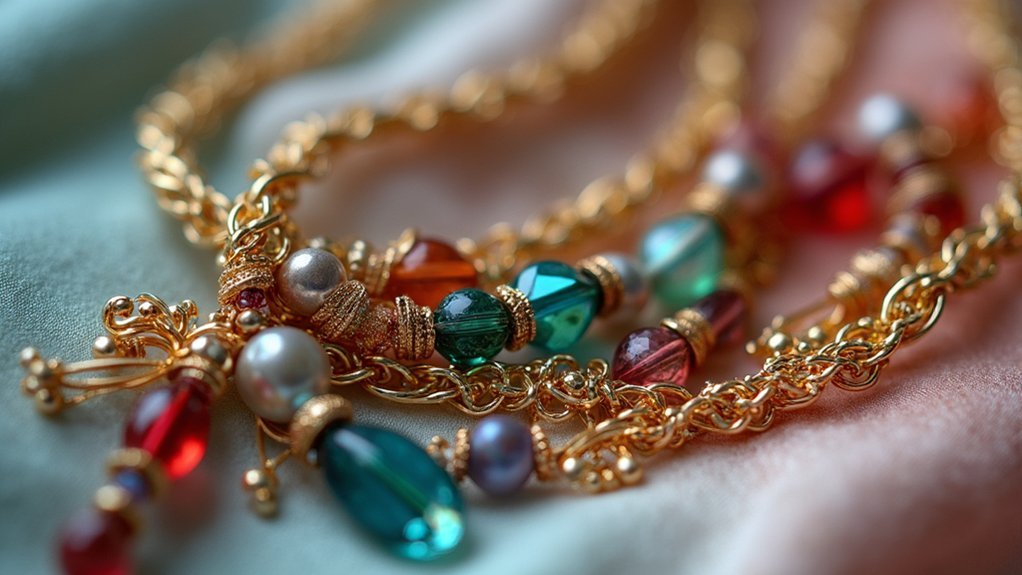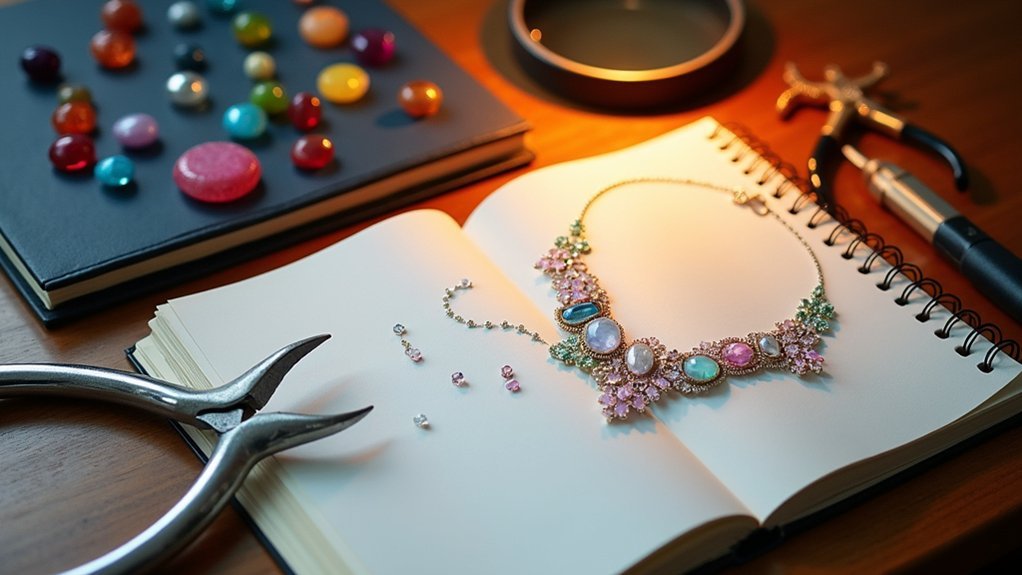When you’re ready to elevate your metalsmithing skills, having the right textbooks makes all the difference. Professional artisans consistently recommend three exceptional resources that balance technical depth with practical application. These aren’t just ordinary guides—they’re thorough references that will transform your understanding of techniques, tools, and materials. What separates these particular books from dozens of others on the market? Their unique approaches might surprise you.
The Complete Metalsmith: An Illustrated Handbook
The Complete Metalsmith stands out as an essential reference that serves both beginners and experienced metalworkers with equal value. Unlike typical jewelry-making manuals, this all-encompassing handbook covers everything from metallurgy and tools to techniques and history.
You’ll appreciate its thoughtful design with easy-navigation tabs and a binding that lies flat while you work. The concise, informative text eliminates fluff, making every sentence count. International readers will find the Celsius temperature measurements particularly helpful.
Whether you’re teaching yourself metalsmithing or expanding your skills, you’ll benefit from the clear illustrations, detailed charts, and practical resources, including supplier lists and workbench plans.
Best For: Beginner to advanced metalworkers seeking a comprehensive reference guide that covers technical fundamentals, practical techniques, and historical context of metalsmithing.
Pros:
- Exceptionally well-organized with tabs and lay-flat binding that makes it practical to use while working at your bench
- Provides concise, information-dense content with clear illustrations that eliminate unnecessary details
- Includes valuable resources like supplier lists, workbench plans, and international measurements (Celsius) for broad accessibility
Cons:
- Not designed as a step-by-step tutorial book for specific jewelry-making projects
- May contain more technical information than casual hobbyists require
- Some readers might find the concise format lacks detailed explanations for complex techniques
Complete Metalsmith: Professional Edition
Widely regarded as the metalsmith’s bible, Tim McCreight’s “Complete Metalsmith: Professional Edition” offers an unparalleled resource for both novice and experienced jewelers. The spiral-bound hardcover lies flat while you work, making it practical for studio reference.
You’ll find thorough coverage of essential techniques including cutting, forging, soldering, and stone setting, all presented with clear graphics and detailed charts. While it doesn’t explore deeply into advanced methods, the extensive appendices provide valuable information on safety, suppliers, and technical formulas.
For serious students, pair this foundational text with Jinks McGrath’s more visual “Encyclopedia of Jewelry-Making Techniques” to round out your reference library.
Best For: Aspiring and professional metalsmiths seeking a comprehensive reference guide that covers essential techniques from basic to intermediate levels while providing practical workshop guidance.
Pros:
- Spiral binding allows the book to lie flat during use, making it exceptionally practical as a workshop reference
- Comprehensive coverage of fundamental metalworking techniques with clear graphics and detailed charts
- Extensive appendices containing valuable information on safety, suppliers, geometric formulas, and technical specifications
Cons:
- Lacks in-depth coverage of advanced techniques, requiring supplementary specialized books for mastery
- Text-heavy approach might benefit from more visual demonstrations for certain techniques
- Some readers may find specific niche areas of metalworking not covered in sufficient detail
Complete Metalsmith: Student Edition
Considered essential for beginners in jewelry making, “Complete Metalsmith: Student Edition” offers an accessible entry point into the world of metalsmithing. You’ll find well-written content complemented by informative diagrams that simplify complex techniques.
The book covers everything from workbench construction to metal heating temperatures, making it ideal for self-taught beginners or students preparing for metal shop classes. While some users note binding issues and its compact size, most praise its reference value.
You can jump into any section at any time, making it practical for quick consultation. Despite minor format concerns, metalsmithing enthusiasts consistently rate this as a must-have resource they return to frequently.
Best For: Beginning metalsmiths and jewelry making students seeking an accessible introduction to essential techniques, tools, and metallurgy concepts.
Pros:
- Well-written content with clear diagrams that simplify complex metalsmithing concepts
- Covers a comprehensive range of topics from building workbenches to metal properties
- Format allows for quick reference with the ability to jump into any section at any time
Cons:
- Binding issues make the book physically difficult to manipulate while working
- Small size and basic content may disappoint those seeking a more advanced textbook
- Some users report an overpowering smell from the paper in new copies
Factors to Consider When Choosing Metalsmithing Textbooks for Serious Students
When selecting metalsmithing textbooks for your serious study, you’ll want to evaluate several critical factors that determine their practical value. Consider the depth of technical content, quality of illustrations, author expertise, and format durability since these elements directly impact your learning experience. The right textbook should combine thorough technical instruction with clear visuals, be written by recognized industry practitioners, and feature binding that withstands heavy workshop use.
Factors to Consider When Choosing Metalsmithing Textbooks for Serious Students
Selecting the right metalsmithing textbooks can profoundly impact a student’s learning journey and skill development. When evaluating potential resources, look for thorough coverage of techniques and tools that serve both beginners and advanced practitioners.
Prioritize books with clear illustrations and diagrams that enhance understanding of complex processes. Well-structured content allows you to easily navigate chapters during workshop sessions when your hands might be occupied.
Don’t overlook supplementary materials like safety guidelines and supplier lists—these practical additions can help you establish an efficient workspace. Finally, seek textbooks recommended by both educators and experienced metalsmiths, as these endorsements typically indicate quality content that’s stood the test of time in actual practice.
Depth of Technical Content
The depth of technical content forms the backbone of any worthwhile metalsmithing textbook. You’ll want to select resources that thoroughly explore essential topics like metallurgy, technique execution, and proper tool usage rather than texts that merely skim the surface.
Look for books that clearly explain fundamental processes—soldering, forging, and stone setting—as these skills form the foundation of metalworking mastery. The best textbooks include extensive visual aids: detailed illustrations, charts, and tables that simplify complex concepts and enhance retention.
Practical elements like safety guidelines, supplier listings, and formula appendices transform theoretical knowledge into applicable skills. If you’re advancing in your craft, prioritize books that reference specialized resources for techniques beyond the main text, allowing you to expand your expertise in specific areas of interest.
Illustration Quality
Visual clarity in metalsmithing textbooks makes the difference between confusion and comprehension for serious students. When evaluating textbooks, look for high-quality illustrations that demonstrate complex techniques and processes step by step. These visual aids will help you visualize the intricate movements and positioning required for successful metalwork.
Well-designed diagrams clarify tool usage, safety protocols, and material properties—essential knowledge whether you’re just starting or advancing your craft. The best texts include informative charts and tables that provide quick access to critical data like melting points and material characteristics.
You’ll find that textbooks with exceptional illustrations serve dual purposes: they’ll boost your confidence during initial learning and remain valuable references throughout your metalsmithing journey, offering both technical guidance and creative inspiration for your projects.
Author Expertise
Beyond quality illustrations, author credentials play a pivotal role in determining a textbook’s value for serious metalsmithing students. When selecting resources, you’ll want to verify that the author possesses recognized expertise in the field, with substantial education and professional experience.
Authors who actively practice metalsmithing bring invaluable real-world insights to their writing, often sharing personal anecdotes and proven techniques that you won’t find in purely theoretical texts. Their practical knowledge makes complex concepts more relatable and easier to apply in your own work.
Look for authors who maintain connections within the metalsmithing community, as they’re more likely to incorporate current trends and innovations into their teaching. These established voices can build your confidence by providing time-tested methods that have been refined through years of hands-on experience.
Format and Binding
Physical construction of metalsmithing textbooks greatly impacts their utility in workshop environments where practical application matters most. When evaluating options, you’ll want to prioritize spiral-bound editions that lie flat on your workbench, allowing hands-free reference while you’re actively creating.
Hardcover editions offer superior durability for workshop conditions where spills, tools, and materials might damage lesser bindings. However, don’t overlook the importance of internal organization—tabs and clear section dividers save valuable time when you need to quickly access specific techniques during projects.
Pay attention to paper quality as well; thicker pages resist tearing and stand up to frequent handling. Books featuring well-designed layouts with extensive visuals, diagrams, and charts will notably enhance your learning experience, making complex metalsmithing concepts more accessible during practical application.
Reference Value
While format considerations address a textbook’s physical usability, the reference value determines how effectively it serves your long-term educational needs. Look for textbooks with extensive coverage of metallurgy, tools, and techniques—these resources will continue supporting your growth long after mastering basics.
Valuable metalsmithing textbooks include practical appendices with safety guidelines, melting points, and tool specifications that you’ll reference repeatedly throughout your career. Clear illustrations, charts, and diagrams enhance understanding of complex processes and improve retention of critical techniques.
The best reference books also provide supplementary resources like supplier lists and professional organizations. These connections extend learning beyond the page and integrate you into the broader metalsmithing community. When investing in educational materials, prioritize those offering both depth of information and practical accessibility.
Frequently Asked Questions
How Long Does It Take to Become Proficient in Metalsmithing?
You’ll need 2-4 years of dedicated practice to become proficient in metalsmithing. It depends on your learning pace, practice frequency, and the techniques you’re mastering. Regular hands-on work accelerates your progress.
What Tools Do Beginners Need to Start Metalsmithing?
You’ll need basic tools to start metalsmithing: a jeweler’s saw, files, hammers, pliers, torch, bench pin, safety glasses, and measuring tools. Don’t forget a dedicated workspace with good ventilation and lighting.
Are Online Metalsmithing Courses as Effective as Textbooks?
Online courses can be highly effective since you’ll get visual demonstrations and real-time feedback. Textbooks provide solid reference but lack the interactive element. Many successful metalsmiths combine both learning approaches for best results.
Which Metals Are Best for Beginners to Practice With?
You’ll find copper and brass ideal for beginners – they’re affordable, malleable, and forgiving. Aluminum’s also great for easy cutting and forming, while sterling silver offers a nice upgrade when you’re ready for precious metals.
How Much Should I Budget for Initial Metalsmithing Supplies?
You’ll need $300-500 for basic metalsmithing supplies. This covers essential tools like hammers, files, pliers, a torch, safety equipment, and starter metals. You can expand your collection gradually as you develop skills.





Leave a Reply